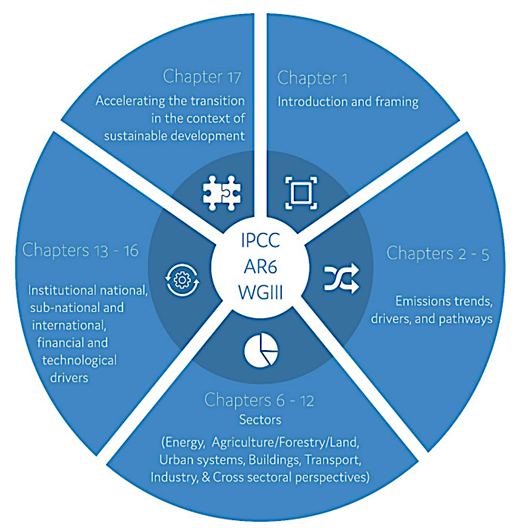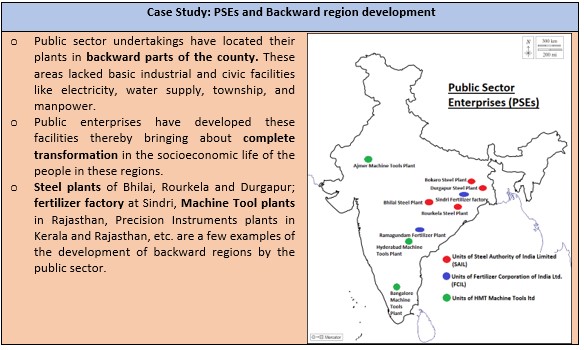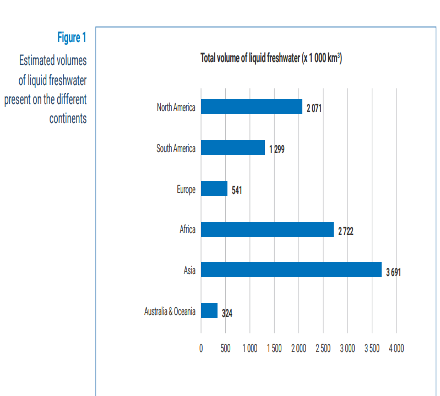23 Apr
IPCC WG 3 – Climate Change 2022: Mitigation of Climate Change (Part II)
Note for Reader: For the convenience of readers and aspirants we have divided this report into two parts- First part discussing the current emission trends, drivers, and pathways. It also provides for sectoral analysis of emissions and their mitigation pathways. It has been already covered in the previous issue of KOSMOS.
Now, this issue of KOSMOS covers the second part. This deals with the Institutional dimensions including national and international policy, financial and technological mitigation drivers and provide the concluding way forwards.
What climate policies are being implemented and are they working?
The report identified that, since IPCC’s AR5, countries have been actively promoting and adopting climate policies which have avoided emissions of several billion tonnes of CO2 each year. The report highlighted the following working climate policies of countries across the globe:
- Climate legislations: One way for a country to tackle climate change is to enshrine such actions in law. Some have taken the lead from the UK’s Climate Change Act and set overarching framework laws covering the whole economy, while others, such as India and Ghana, have sector-specific laws covering areas such as energy efficiency and renewables.
- By 2020, the report says that climate legislations primarily targeting greenhouse gases were in place across 56 nations, covering 53% of emissions.
- As of 2016, climate laws were associated with an annual reduction in global emissions of 9bn tonnes of CO2 (GtCO2). Cumulative CO2 emissions savings from 1999 to 2016 amount to 38 GtCO2, or one year’s worth of global CO2 output.
- The chart below shows the prevalence of climate change mitigation legislations by % of countries both globally (left chart) and across regions (right chart). Regions are divided into developed countries (DEV), Asia and developing Pacific (APC), Eastern Europe and West-Central Asia (EEA), Africa (AFR), Latin America and the Caribbean (LAM) and Middle East (MDE). Source: IPCC (2022)
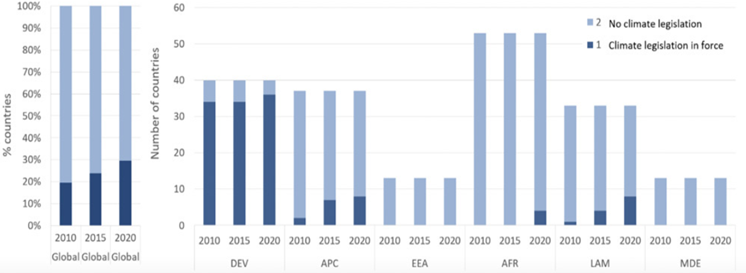
- Climate targets: There are three key varieties of climate targets: purely national strategies; nationally determined contributions (NDCs), established under the Paris Agreement; and long-term strategies that look beyond the 2030 targets set in most NDCs.
- As of 2020, 90% of global emissions are now covered by climate targets.
- The report states that many long-term strategies refer to net-zero emissions or variations of that term by 2050 or 2060.
- A recent estimate by the Net Zero Tracker project found that 135 countries and 88% of emissions are now covered by net-zero targets.
- The chart below shows the prevalence of climate targets by % of countries both globally (left chart) and across regions (right chart).
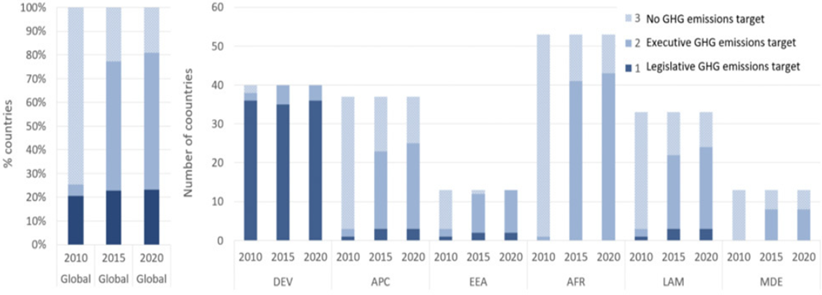
- Institutions to tackle Climate Change: Relatively few countries, including the UK, China and New Zealand have set up bodies specifically tasked with climate change mitigation, requiring broad national political agreement. Many developing countries simply lack the capacity to establish such institutions.
- More often, nations have “layered” climate responsibilities onto pre-existing institutions, such as the US Environmental Protection Agency (EPA).
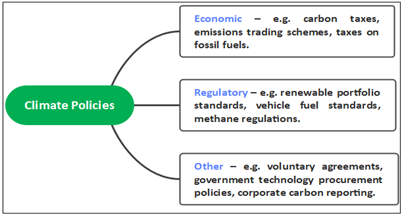
- Carbon pricing: Carbon pricing – including carbon taxes and emissions trading schemes (ETS) – has been one of the most widely used and effective options to reduce emissions.
- As of May 2020, 30 carbon tax regimes and 31 ETSs were planned or in effect, covering 22% of annual global emissions.
- However, carbon pricing has limitations – for example, in areas that are less sensitive to price incentives, such as energy efficiency, or for higher cost mitigation measures. The report adds that carbon taxes are one of the least popular mitigation policy options among the public.
- Others: There is high agreement in the report that renewable portfolio standards and feed-in tariffs have played an essential role in the massive expansion of renewable energy capacities.Such regulatory policies have proven effective in reducing emissions.
- The report also emphasized that removing fossil fuel subsidies could cut global greenhouse gas emissions by up to 10% by 2030. However, the fossil fuel industry lobbies hard to maintain these subsidies, and protests from Cameroon to Bolivia have forced governments to abandon subsidy reform attempts, due to the additional costs borne by consumers. The report gives Indonesia as an example of a nation that has successfully removed subsidies.
- The report also identified that, a higher share of green parties in a parliament is associated with lower greenhouse gas emissions, and left-wing parties tend to adopt more pro-climate policy positions.
- Other miscellaneous features of systems that are effectively tackling climate change include proportional representation, broader public participation in decision making and fewer organizations involved in lobbying the government.
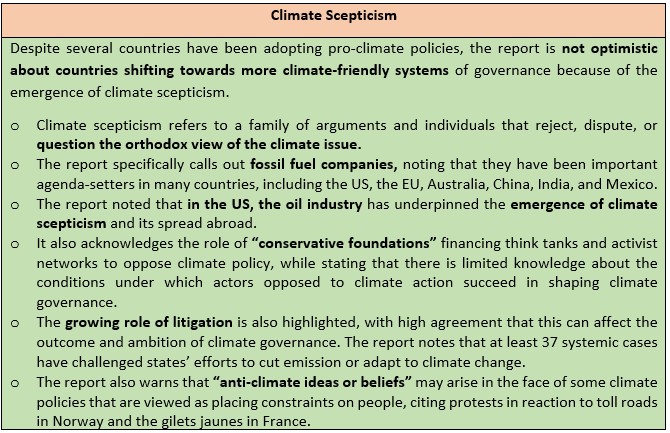
Conclusion: Though the report talks about the expansion of government climate policies, it also notes that “big gaps” remain and the stringency of many policies “falls short of what is needed”. Policy coverage is weaker for non-CO2 gases and industrial emissions, it adds. The report called for a “comprehensive” and economy-wide policy packages rather than single-policy instruments to improve climate change mitigation and strengthen climate governance.
Are the Paris Agreement and climate finance helping cut emissions?
- The report provides a “preliminary assessment” of the Paris agreement – a landmark treaty that built on earlier progress made with the UN Framework Convention on Climate Change (UNFCCC) and the Kyoto Protocol.
- Report stated that Paris agreement created a “global direction of travel” through international cooperation and extended emissions goals to developing countries and the developed countries which enabled them to set their own targets, known as nationally determined contributions (NDCs).

- The report notes that some analysts have linked the consideration or adoption of mid-century net-zero targets by 127 countries to their participation in the Paris Agreement and its Article 4, which commits to ramping up ambition over time.
- Outside of the UN climate process, other forms of international cooperation can both help and hinder climate action.
- The report notes that so far global aviation and shipping targets “fall far short” of what is required to achieve the Paris Agreement targets. It adds that international cooperation fails to fully address transboundary issues associated with solar radiation modification and carbon dioxide removal.
Way forward: In order to achieve the Paris Agreements goals, the report suggests international cooperation efforts should better address sector-specific technical and infrastructure challenges and finalize rules for public climate finance.

Conclusion: Financial flows fall short of the levels needed to achieve the ambitious mitigation goals, however. The gaps are the widest for the agriculture, forestry, and other land uses (AFOLU) sector and for developing countries.
- But the global financial system is large enough and “sufficient global capital and liquidity” exist to close these gaps.
- There is high confidence that climate finance from richer countries is likely to be a key to a successful low-carbon transition globally. The report calls for focus on climate finance at all levels: to address global inequity, to target national-level policies and to support local communities.
What are the costs and benefits of efforts to cut emissions?

- A key reason that climate action is economically advantageous is because of the impacts on society that are avoided by slowing global warming. And there will be various co-benefits from tackling climate change. For example- the economic benefits on human health from air quality improvement arising from mitigation action can be of the same order of magnitude as mitigation costs, and potentially even larger.
- However, historically, assessments of mitigation costs have typically not included co-benefits and avoided impacts. Instead, they have tended to be treated separately.
- Even discounting for co-benefits or avoided impacts, the GDP slowing due to mitigation will be very small. Annualized over the whole century, it is equivalent to approximately 0.04% a year for 1.5C pathways with or without overshoot. For 2C pathways, it is 0.03% per year.

Conclusion: The report concludes with high confidence, that mitigation options costing $100/tCO2e or less could reduce global GHG emissions by at least half the 2019 level by 2030.
How much innovation and new technology is needed to hit climate goals?
- The WG3 report is the first to include a chapter on innovation, technology development and transfer.
- The report says that innovation can leverage action to mitigate climate change by reinforcing other interventions and can support system transitions to limit warming and help shift development pathways.
- The report defines three key phases of the innovation cycle.

- The report stated that, with the help of innovation, the unit costs of several low-emission technologies have fallen continuously since 2010.
- Renewable energy costs have fallen, while adoption has increased. For example, it says that since 2010, the global average cost of solar energy, wind energy and lithium ion batteries has decreased by 85%, 55% and 85%, respectively.

- However, it took 60 years for solar to become cheap enough for widespread adoption – which the report says is too slow for addressing climate change if a technology is now still at the lab scale. As such, it says that we need to learn from the solar model and use public policy to speed up innovation over much shorter time frames, such as 15 years or less.
- Energy and climate goals: Innovation in energy technologies is a “key driver” of emissions reductions in model-based scenarios of future emissions.
- For example, to limit warming to 2C above preindustrial levels, solar capacity will need to increase by a factor of 15 by 2050 compared to 2020. Meanwhile, a 10-fold increase in wind and 87% phase-out of coal are needed.
- Transformational changes: To limit warming to 2C or below, the Report outlines the key stages in undertaking such a socio-technical transition:

- Digitalization: The report stated that an area where sustainable development, climate change mitigation and technological change interact is digitalization. Digital technologies can promote large increases in energy efficiency through coordination and an economic shift to services, but they can also greatly increase energy demand because of the energy used in digital devices.
- Developing and least-developed countries: The report highlighted that adoption of low-carbon technologies lags in developing countries, particularly least developed ones, due in part to weaker innovation systems and adoption capacities.
- The international cooperation on technology development and transfer can help developing countries to achieve their climate goals more effectively, and often helps to address their sustainable development goals.
Will meeting climate goals help or hinder sustainable development?

- AR6 lays out several ways in which the SDGs can be achieved at the same time as climate mitigation and adaptation – but also warns of areas where trade-offs mean that policies will need to be carefully designed to avoid negative impacts on either development or climate change.
- Climate goals and SDG2: Mitigation can lessen food insecurity by alleviating some of the negative impacts of climate change on agriculture, such as a loss of crop productivity.
- Climate goals and SDG3: Mitigation will also be beneficial for human health –both in the long-term benefits of alleviating climate impacts, but also on shorter timescales. E.g., benefits of improved air quality, reduced exposure to particulate matter etc.
- Climate Goals and SDG7: Currently, more than 1 billion people worldwide do not have access to Providing them with affordable and clean energy will eradicate extreme poverty, energy poverty and provide decent living standards, while at the same time contribute towards significant global emissions reduction.
- Climate goals and SDG15: There are “high expectations” for land to contribute to climate mitigation, including through afforestation and the growth of bioenergy crops. As a result, many climate policies in the AFOLU sectors “simultaneously generate impacts on mitigation, adaptation and the SDGs”.
- Development v/s GHG emissions across the countries: The top 10% earning households globally are responsible for 34-45% of consumption-based emissions, while the bottom half of households contribute only 13-15% of global emissions.
- Although higher incomes are associated with higher emissions, the absolute effect of economic inequality reduction on emissions remains moderate.
- Though sustainable development offers a comprehensive pathway towards ambitious climate change action, many countries do not directly address the SDGs alongside climate policies. The report notes that very few NDCs contain any reference to the goals.
- The report notes with medium confidence that higher inequality within a country can negatively impact both high- and low-income populations’ willingness to accept environmental-protection policies or adopt mitigation-friendly lifestyles.
- The figure below shows the relationship between the human development index and per-capita GHG emissions. Countries and regions are highlighted on the figure with different coloured circles; the area in green marks the parameters of sustainable development.
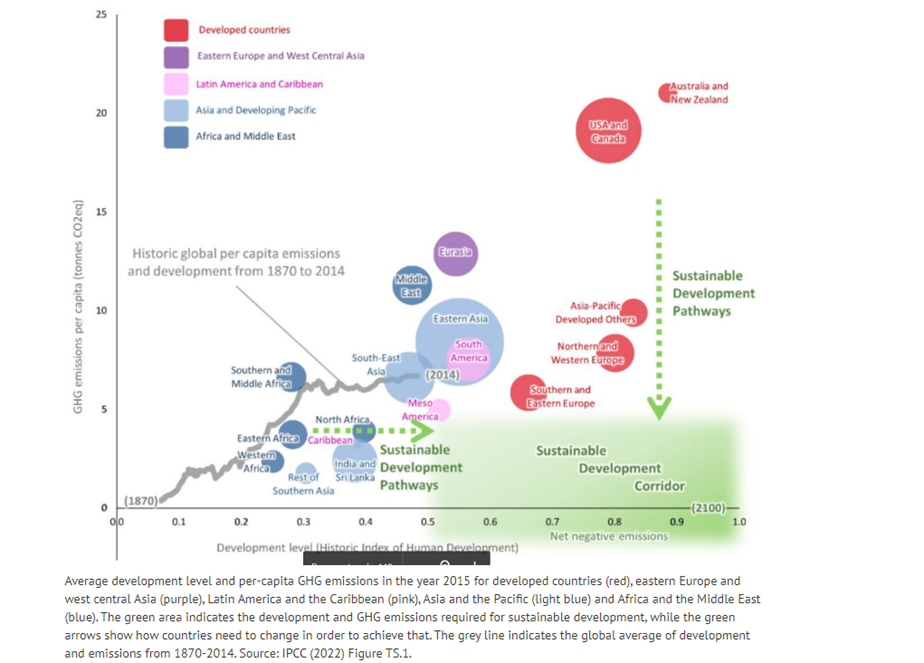
Conclusion: A “just transition” – securing livelihoods and addressing inequalities while moving towards a low-carbon future – will be essential to reducing climate risks and addressing sustainable development priorities. A just transition requires not just rapid change, but also removing the underlying drivers of vulnerability and high emissions and taking into consideration the interests of different communities and cultures. Furthermore, the transition must not perpetuate asymmetries between richer and poorer states and people, nor replace old forms of injustice with new ones.
Source:
Coastal Erosion in India
In news
Recently, Ministry of Earth Science informed Lok Sabha that about 34% of Indian coastline is under varying degrees of the threat.
Indian coast and its Geomorphology in general
Indian mainland coast includes 9 coastal states and 2 union territories having 66 coastal districts. Morphology of the coast consists of 43% sandy beach, 11% rocky coast, 36% of muddy flats 10% of marshy coast, 97 major estuaries and 34 lagoons. There are 13 major ports, 46 fishing harbours and 187 minor ports.
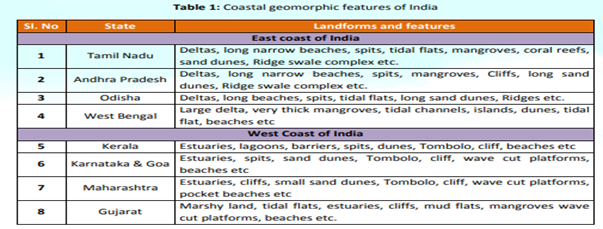
Status of Shoreline Changes on Indian Coasts
- The National Centre for Coastal Research (NCCR), Chennai, an attached office of the Ministry of Earth Sciences (MoES) is monitoring shoreline erosion since 1990 using remote sensing data and GIS mapping techniques.
- About 6,907.18 km long Indian coastline of mainland has been analysed from 1990 to 2018. According to the NCCR report,
- More erosion is occurring in Eastern Coastthan the Western coast.
- Eastern coast witnesses lot of rainresulting in rough seas most of the time a year. Eastern coast witnesses the South-west Monsoon (June to September), and the North-east Monsoon (October to December) which brings rain to coastal Andhra Pradesh and Tamil Nadu.
- Eastern coast underwent more erosion due to frequent Cyclones from Bay of Bengal, compared to the western coast, which remained largely stable.
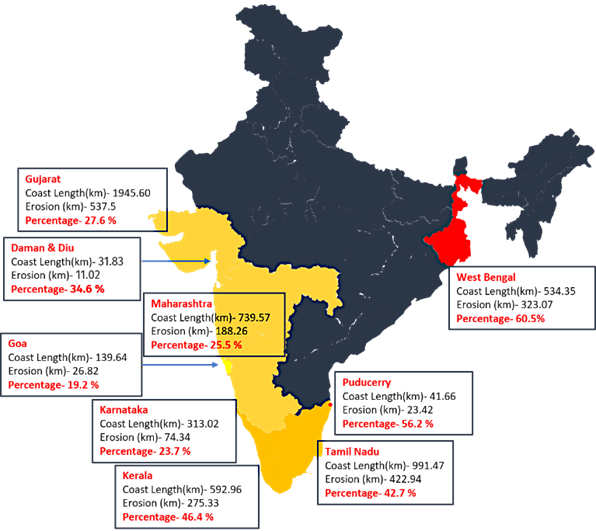

Factors Affecting Coastal Erosion
- Natural
-
- Wave energyis considered to be the primary reason aggravated by Sea level rise.
- Natural hazardslike extreme cyclones, thermal expansion of seawater, storm surges, tsunami etc, hamper the natural rhythm and increased erosion due to precipitation.
- Strong littoral driftresulting in sand movement.
- Heavy rainfall enhances the saturation of soils, leading to a reduction in the soil’s shear strength, increasing the chance of slope failure/landslides.
- Sea Level Rise: Sea level has risen about 40 cm in the past century and is projected to rise another 60 cm in the next century. Sea level has risen nearly 110 meters since the last ice age. Due to global warming, average rise of sea level is of the order of 1.5 to 10 mm per year. It has been observed that sea level rise of 1 mm per year could cause an inundation of the order of about 0.5 m per year (IPCC report).
- Anthropogenic
-
- Dredging, sand mining and coral mininghave contributed to coastal erosion causing sediment deficit, modification of water depth leading to longshore drift and altered wave refraction.
- Coastal erosion: construction of upstream dams and fishing harbours reduced the flow of sediments from river estuaries, with increased coastal erosion, a widespread consequence like coastal wetlands disappearance is likely to occur.
- Rapid urbanisation resulted in, enlargement of natural coastal inlets and dredging of waterways for navigation, port facilities, and pipelines exacerbate saltwater intrusion into surface and ground waters.

Broad Impacts of Coastal Erosion
- Population Vulnerability: Presently about 40% of the world’s population lives within 100 kilometres of the coastline. These coastal regions are undergoing environmental decline and the problem is particularly acute in developing countries.
- Land loss is a result of decreased sediment delivery by the rivers, and also through accentuated rates of sea-level rise.
- Depleted resources: heavy use of fisheries has reduced endemic coastal fish stocks to about 10-30 percent of the supply that existed 30 years ago.
- Ecological degradation: Half of the world’s wetlands disappeared, half of all mangroves, and nearly 60 percent of the world’s coral reefs are seriously degraded.
- Pollution: from industry, agriculture, and urban areas is degrading the quality of much of the world’s fresh water.

India’s Policy on Coastal displacement
- 15th Finance Commission had recommended the creation of a National Disaster Risk Management Fund (NDRMF) and State Disaster Risk Management Fund (SDRMF) comprising a Mitigation Fund at the National and State-levels (NDMF/SDMF), and a Response Fund at the National and State level (NDRF/SDRF) for the award period from 2021-22 to 2022-26.
- The Commission has also made specific recommendations for ‘Mitigation Measures to Prevent Erosion’ under NDMF and ‘Resettlement of Displaced People Affected by Erosion’ under NDRF.
Conclusion
The challenge for policymakers and coastal resource managers is to figure out how to reap the economic benefits of coastal resources while preserving them for future generations. Addressing population issues and understanding how policymakers can integrate population and resource management issues for using and safeguarding the world’s coasts and the resources they provide is key to achieving such balance.
Source:
Places in News
|
Khijadia Wildlife Sanctuary
|
|
Bakhira Wildlife Sanctuary
|
|
Srisailam Dam
|
|
Kamrup
|
|
Coonoor
|
|
Sepahijala
|
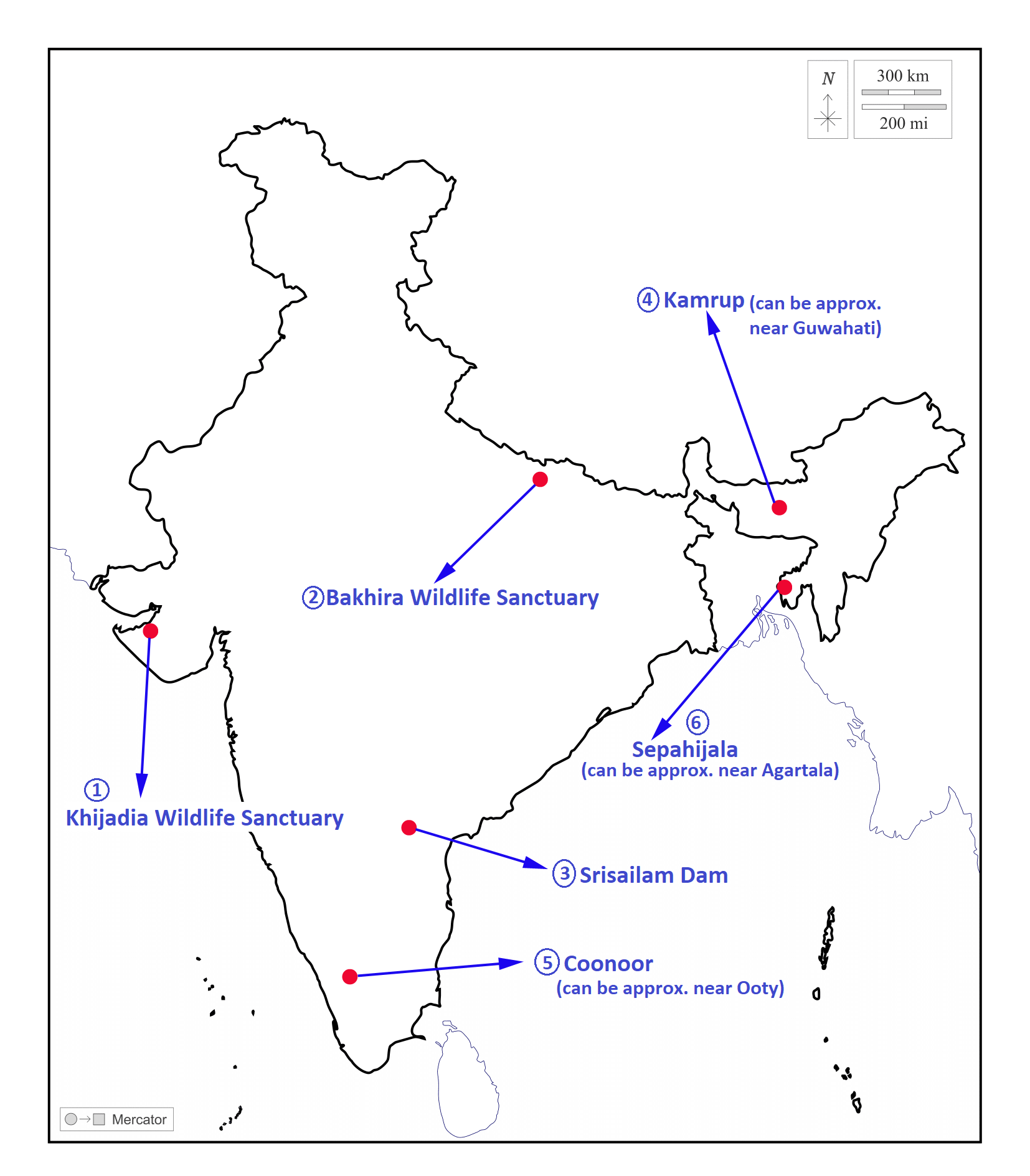
Share the article
Get Latest Updates on Offers, Event dates, and free Mentorship sessions.

Get in touch with our Expert Academic Counsellors 👋
FAQs
Geography Current Affairs focuses on the contemporary issues, events, and developments in the field of geography. It covers recent geographical phenomena, environmental changes, geopolitical shifts, and related news. This differs from regular geography studies which may focus more on foundational concepts, historical contexts, and theoretical frameworks.
Updates are provided regularly to ensure that subscribers stay informed about the latest developments in geography. Typically, updates are provided on a fortnightly basis, depending on the frequency of significant events and changes in the field.
Absolutely. Geography Current Affairs serves as a valuable resource not only for Geography optional but also for GS papers, especially GS Paper 1 (covering Indian Heritage and Culture, History, and Geography of the World and Society) and GS Paper 3 (covering Technology, Economic Development, Biodiversity, Environment, Security, and Disaster Management). It aids in building a holistic understanding of various topics and strengthens answer-writing skills by incorporating contemporary examples and perspectives.
Geography Current Affairs holds immense importance for UPSC preparation, particularly for aspirants opting for Geography optional. It helps candidates stay updated with the latest developments, geographical phenomena, environmental issues, and geopolitical shifts worldwide, aligning them with the dynamic nature of the subject as tested in the UPSC examinations.

